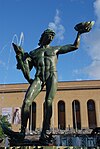
The Great Belt Bridge or Great Belt fixed link is a multi-element fixed link crossing the Great Belt strait between the Danish islands of Zealand and Funen. It consists of a road suspension bridge and a railway tunnel between Zealand and the small island Sprogø in the middle of the Great Belt, and a box-girder bridge for both road and rail traffic between Sprogø and Funen. The total length is 18 kilometres (11 mi).

Västergötland, also known as West Gothland or the Latinized version Westrogothia in older literature, is one of the 25 traditional non-administrative provinces of Sweden, situated in the southwest of Sweden.

New Älvsborg, so-called to distinguish it from the earlier fortress at Old Älvsborg, is a sea fort on the island of Kyrkogårdsholmen within the urban area of modern Gothenburg, Sweden. Situated near the mouth of the Göta River, it protected what was at the time of its construction Sweden's only access to the North Sea and the Atlantic Ocean. Construction began in 1653, and the fortress remained in service until 1869, though it only saw significant action in one conflict, the Great Northern War.
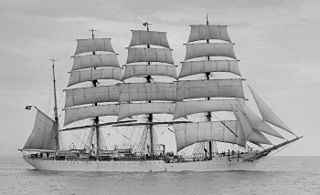
Viking is a four-masted steel barque, built in 1906 by Burmeister & Wain in Copenhagen, Denmark. She is reported to be the biggest sailing ship ever built in Scandinavia. In the 21st century her sailing days have drawn to a close, and she is now moored as a botel in Gothenburg, Sweden.
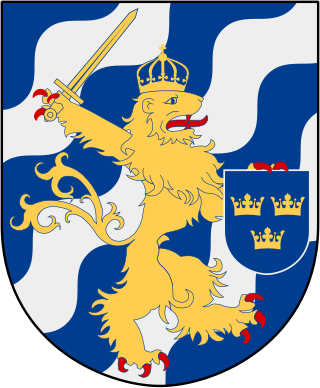
The history ofGothenburg begins with the foundation of the city in 1621, although by that time people had already been living in the area for thousands of years, since the Neolithic Period, and moreover there had already been a series of earlier settlements on the lower Göta Älv, including one which also bore the name Gothenburg.

Göteborgsvarvet is an annual half marathon running competition in Gothenburg, Sweden. It is the largest annual running competition in the world in terms of entries, with its 62,000 entries for the Göteborgsvarvet competition on 18 May 2013. In 2016, 64,500 people entered the race. The youngest runner was 17 years old and the oldest female runner 83 and male runner 87.

The Volvo Museum was situated in Gothenburg, Sweden. It covered the development of Sweden's leading vehicle manufacturer Volvo, from the first ÖV 4 to their then current cars, trucks, buses and other products. The museum also had displays of Volvo Aero and Volvo Penta products, and many other exhibits, including the joint desk of Assar Gabrielsson and Gustaf Larson from the pioneering years of the company.

Älvsborg Fortress, with its main facility Oscar II's Fort built 1899–1907, is a now-defunct Swedish fortification located at the mouth of the Göta River in the Älvsborg district of Gothenburg, Sweden.
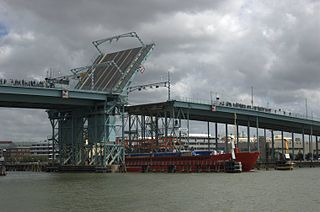
Götaälvbron was a bascule bridge in central Gothenburg, Sweden, carrying normal road vehicles and trams. The bridge was constructed in 1937 to 1939 and in 1966 it was widened. It was closed for decommissioning in June 2021. Constructed of steel beam, the bridge had a total length of 927 m (3,041 ft) and width of 20 m (66 ft). The mid span had a free height of 19.5 m (64 ft).

The Battle of Gothenburg was a Danish attempt to destroy the Swedish squadron in Gothenburg, which was led by Olof Strömstierna. The Danes were led by the famous Peter Tordenskjold. The Swedish land defence was led by Fredrik of Hessen, and it consisted of the land batteries Billingen and Rya Nabbe with 12 guns each, and the Älvsborg fortress, who had 400 soldiers with 90 guns.

Älvsborg is an urban district of Gothenburg in Sweden.
Gothenburg Squadron was a naval squadron of the Swedish Navy which has operated in various forms from 1939 to 1951. The unit was based at Gothenburg naval base at Nya Varvet in Gothenburg.

The battles at Göta älv were a series of battles and sieges which took place in and around the Gothenburg area between 1717 and 1719, between the Swedish Empire and Denmark–Norway, during the Great Northern War.
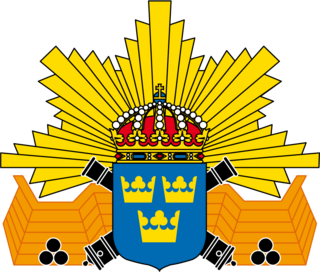
The 1st Marine Regiment is an amphibian regiment of the Swedish Amphibious Corps based at the Berga Naval Base in Berga, Haninge Municipality. Raised from the Vaxholm Coastal Artillery Regiment in 2000 when the Swedish Amphibious Corps was formed, the 1st Marine Regiment has a large geographical spread where units are trained and grouped at Berga, south of Stockholm, in Gothenburg and in Gotland. Although the unit's natural combat environment is coastal zones, river deltas and other amphibious areas, the unit has the ability to operate in all types of terrain, such as desert. The 1st Marine Regiment has participated in operations in, for example, Kosovo, Gulf of Aden, Chad and Afghanistan.

The 4th Marine Regiment is an amphibian regiment of the Swedish Amphibious Corps based in Gothenburg. Raised from Älvsborg Coastal Artillery Regiment in 2000 when the Swedish Amphibious Corps was formed, the 4th Marine Regiment only operated for four years before being disbanded in 2004. The regiment was reinstated on 1 October 2021.

The Älvsborg Coastal Artillery Regiment, designation KA 4, was a Swedish Navy coastal artillery regiment of the Swedish Armed Forces which operated between 1942 and 2000. The unit was based in Gothenburg.

The West Coast Naval Command was a naval command within the Swedish Navy that operated in various forms in from 1928 to 2000. The unit was based in Gothenburg.

Älvsborg, now generally known as Old Älvsborg or Älvsborg Castle to distinguish it from the later New Älvsborg and Älvsborg Fortress, was a medieval castle situated on the rocky outcrop known as Klippan, on the south bank of the Göta Älv river within the urban area of the modern city of Gothenburg. It was demolished in the late seventeenth century, but some of its ruins are still visible today, close to the southern pylon of the Älvsborg Bridge.

The Torstenson Palace is a building on Södra Hamngatan in Gothenburg, also known as Kungshuset because it was formerly the Swedish king's residence in Gothenburg. It is currently the residence and offices of the landshövding of Västra Götaland County.



















